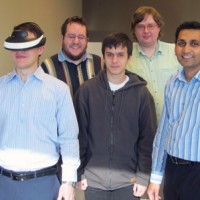Virtual reality enters the OR
- Details
- Published on Tuesday, 11 December 2012 12:54
- Written by Paul Gordon
System being developed in Peoria will train surgeons; Peoria NEXT grant will help further research
A Peoria start-up company, VirtuSense Technologies, is quickly becoming cutting edge. Literally.
The company, a spinoff of Bradley University and Peoria Robotics, is developing virtual reality technology that will be used to train surgeons and emergency physicians in performing surgery while providing instant feedback.
Peoria NEXT presented VirtuSense a $50,000 grant that, combined with federal military grant funding, will continue the research in Peoria.
There was a time that about the closest thing to virtual reality surgery was that game called Operation! we played as kids. The object was to remove things from the "patient" and one wrong move or unsteady hand meant a loud buzzer sounded, denoting failure.
Now there is a new company called VirtuSense Technologies that has set up operations at the Peorian NEXT Innovation Center that is creating a way to train real-life doctors how to perform surgery without the use of board games or even cadavers, the usual way such training is done.
Using virtual reality, the company that is a spinoff of Peoria Robotics at Bradley University, is developing methods sure to be more cost-effective and efficient for the medical industry moving forward, its chief of technology said Tuesday.
Deepak Gaddipati said VirtuSense is already collaborating with physicians at OSF HealthCare and the University of Illinois College of Medicine at Peoria to develop "product platforms" that will result in better data for training surgeons in the future.
Gaddipati said VirtuSense uses disposable synthetic tissue, allowing medical trainees to perform surgical procedures while providing real-time analysis of their actions. This system will allow trainees to experience the nuances of real-life surgery before operating on a patient.
"We are working 70 or 80 hours a week trying to get product out the door because we are working to take our technology to the next step, which will be real-time surgical simulation using virtual patients," Gaddipati said. The simulation would produce instant feedback, not unlike that old board game in that the trainees will know instantly what mistakes were made.
But this is no game. "This is advanced training where we are immersing people into the simulation and teaching them," Gaddipati said.
VirtuSense was awarded a $50,000 grant from Peoria NEXT, through its research grant program, to help continue the research necessary for the five-person staff. "This grant supports innovation and the implementation of commercialization in the areas of life science, physical science, material science, and engineering science," said Grant Brewen, CEO of Peoria NEXT. "VST was chosen based on the company's inter-institutional collaboration, scientific/technical merit, commercialization potential, and future access to funding."
Gaddipati said the Peoria NEXT grant will allow his team to continue researching ways to develop cost effective systems to improve simulators used for training medical personnel. "This grant enables the development of preliminary components for an augmented reality based surgical training system that combines virtual patient simulation with trainee skill evaluation capabilities," he said.
Already VirtuSense is in the middle stages of a grant award from the U.S. Army to develop medical simulation to train doctors in the field as well as to train soldiers in what is known as "buddy care."
That simulation, using virtual reality technology, can help soldiers learn how to detect internal hemorrhages after a traumatic event that could save lives. Many lives have been lost, Gaddipati said, because a wounded soldier appeared fine on the outside but had internal wounds that were undetected until it was too late.
A virtual reality glove worn by the trainee puts force on the fingers that simulates an internal hemorrhage so the soldier knows what to feel for when a buddy is wounded. "This is technology the Army and the Navy need now," Gaddipati said.
Brewen said the grant award keeps with strategies Peoria NEXT announced early this year that are geared toward attracting technology commercialization opportunities by focusing resources and energy on four main areas of concentration. "These are four areas where we felt the region had the technical knowledge and expertise. Medical technology is one them," he said.
He added it also is one of the fastest growing industries and that the Peoria region has a medical infrastructure that has seem more than $600 million in recent investments, additions and renovations.
"This seemed like a perfect fit for Peoria NEXT," Brewen said. "The focus of NEXT Medical is to generate funding to sponsor and manage research in the areas of cancer biology, health informatics, medical education and medical device development. With vision that extends far outside the laboratory, Next Medical can aggregate funding from both public and private sources, develop research projects involving multiple institutions and actively manage their funding and accountability."
Paul Gordon is editor of The Peorian. He can be reached at 692-7880 or editor@thepeorian.com


















































